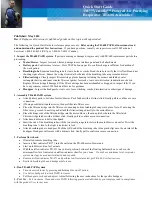
5
English
Saf
e
ty Inf
ormation
•
For use in Europe:
This appliance can be used by children
aged from 8 years and above and persons with reduced
physical, sensory or mental capabilities or lack of experience
and knowledge if they have been given supervision or
instruction concerning use of the appliance in a safe way and
understand the hazards involved. Children shall not play with
the appliance. Cleaning and user maintenance shall not be
made by children without supervision.
Installing the unit
WARNING
IMPORTANT: When installing the unit, always remember
to connect first the refrigerant tubes, then the electrical
lines.
• Upon receipt, inspect the product to verify that
it has not been damaged during transport. If the
product appears damaged, DO NOT INSTALL it and
immediately report the damage to the carrier or
retailer (if the installer or the authorized technician
has collected the material from the retailer.)
• After completing the installation, always carry out a
functional test and provide the instructions on how to
operate the air conditioner to the user.
• Do not use the air conditioner in environments with
hazardous substances or close to equipment that
release free flames to avoid the occurrence of fires,
explosions or injuries.
• Do not install the product in a place where
thermohygrostat is needed (such as server room,
machinery room, computer room, etc.) Those places
do not provide guaranteed operation condition of the
product therefore performance can be poor in these
places.
• Do not install the product in a ship or a vehicle
(such as a campervan). Salt, vibration or other
environmental factor may cause the product
malfunction, electric shock or fire.
• Our units should be installed in compliance with the
spaces shown in the installation manual, to ensure
accessibility from both sides and allow repairs
or maintenance operations to be carried out. The
unit’s components should be accessible and easy to
disassemble without endangering people and objects.
• For this reason, when provisions of the installation
manual are not complied with, the cost required to
access and repair the units (in SAFETY CONDITIONS,
as set out in prevailing regulations) with harnesses,
ladders, scaffolding or any other elevation system
will NOT be considered part of the warranty and will
be charged to the end customer.
• The outdoor unit shall be installed in an open space
that is always ventilated.
• The local gas regulations shall be observed.
• To handle, purge, and dispose the refrigerant, or
break into the refrigerant circuit, the worker should
have a certificate from an industry-accredited
authority.
• While in installation or relocation of the product, do
not mix the refrigerant with other gases including air
or unspecified refrigerant. Failure to do so may cause
pressure increase to result in rupture or injury.
• Do not cut or burn the refrigerant container or
pipings.
• Use clean parts such as manifold gauge, vacuum
pump, and charging hose for the refrigerant.
• Installation must be carried out by qualified personnel
for handling the refrigerant. Additionally, reference
the regulations and laws.
• Be careful not to let foreign substances (lubricating
oil, refrigerant, water, etc.) enter the pipings.
• When mechanical ventilation is required, ventilation
openings shall be kept clear of obstruction.
• For disposal of the product, follow the local laws and
regulations.
• Do not work in a confined place.
• The work area shall be blocked.
• The refrigerant pipings shall be installed in the
position where there are no substances that may
result in corrosion.
• The following checks shall be performed for
installation:
– The charging amount depends on the room size.
– The ventilation devices and outlets are operating
normally and are not obstructed.
– Markings and signs on the equipment shall be
visible and legible.
• Upon leakage of the refrigerant, ventilate the room.
When the leaked refrigerant is exposed to flame, it
may cause generation of toxic gases.






































